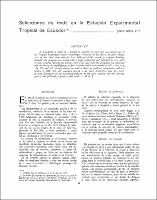Mostrar el registro sencillo del ítem
Selecciones de maíz en la Estación Experimental Tropical de Ecuador
| dc.contributor.author | Soria V., Jorge | |
| dc.date.accessioned | 2025-09-05T16:34:28Z | |
| dc.date.available | 2025-09-05T16:34:28Z | |
| dc.date.issued | 1956-10-01 | |
| dc.identifier.uri | https://repositorio.catie.ac.cr/handle/11554/14004 | |
| dc.description.abstract | A description is made of a method of selection in corn that was carried out in the Tropical Experiment Station, Pichilingue (Province of Los Rios), Ecuador. Eleven ears of low land corn, selected from different fields, served as original breeding material; the program was started with a selfed generation and followed by two cycles of mass selection. During the process, part of the seed from the progenies was separated and this led to the establishment of five varieties which were named as EET: 102, 103, 104, 105, and 106 A local variety was used as check on yield test comparisons and was known as EET 101; all selections proved to be more productive than the check A brief description of the hereditary make-up of the basic material and the selection process that followed, is given in this article. | es_ES |
| dc.format.extent | 3 | es_ES |
| dc.language.iso | es | es_ES |
| dc.publisher | Instituto Interamericano de Ciencias Agrícolas (IICA) | es_ES |
| dc.relation.ispartof | Turrialba Vol. 6, no. 4 | es_ES |
| dc.subject | Maíz||maize||milho||maïs | es_ES |
| dc.subject | Zea mays||Zea mays||Zea mays||Zea mays | es_ES |
| dc.subject | Datos experimentales||experimental data||undefined||données expérimentales | es_ES |
| dc.subject | Zona tropical||tropical zones||zona tropical||zone tropicale | es_ES |
| dc.subject | Ecuador||Ecuador||Equador||Équateur | es_ES |
| dc.subject.other | Sede Central | es_ES |
| dc.title | Selecciones de maíz en la Estación Experimental Tropical de Ecuador | es_ES |
| dc.type | Artículo | es_ES |
| dc.identifier.status | openAccess | es_ES |
Ficheros en el ítem
Este ítem aparece en la(s) siguiente(s) colección(ones)
-
Turrialba [2650]


